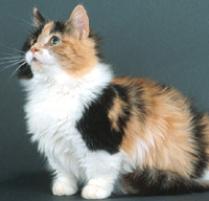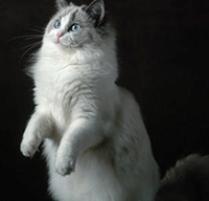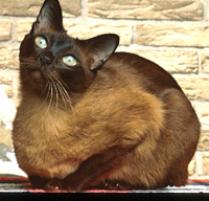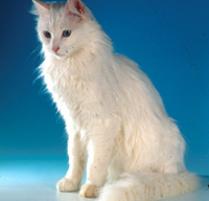There are a few basics to understand in
taking care of a cat. Proper feeding, housing, litter box, grooming, handling,
play and exercise are very important for your cat to live a long and happy
life. Also take your cat to the vet for a check-up at least once a year. Here
are some cat care tips for optimal cat care:
·
Feeding
Feed your cat premium cat food. High quality cat foods meeting AAFCO cat food standards will ensure that your cat gets a balanced diet with the right nutrients. Feline diets deficient in certain nutrients can cause diseases, including blindness.
Provide your cat with a fresh supply of water throughout the day. If you make a change to your cat's diet, do so as gradually as possible. If moist pet food goes uneaten for two hours, refrigerate it.
Feed your cat premium cat food. High quality cat foods meeting AAFCO cat food standards will ensure that your cat gets a balanced diet with the right nutrients. Feline diets deficient in certain nutrients can cause diseases, including blindness.
Provide your cat with a fresh supply of water throughout the day. If you make a change to your cat's diet, do so as gradually as possible. If moist pet food goes uneaten for two hours, refrigerate it.
·
Housing
Keeping your cat indoors or outdoors can depend on many factors, including your lifestyle and where you live. Many cat organizations recommend keeping your cat indoors for safety, better health and a longer life.
Allow your cat to choose favorite spots to hang out around the house, and then make it more comfortable with blankets and pillows, or a cat bed. You can provide your cat with scratch pads or scratching posts as well.
Keeping your cat indoors or outdoors can depend on many factors, including your lifestyle and where you live. Many cat organizations recommend keeping your cat indoors for safety, better health and a longer life.
Allow your cat to choose favorite spots to hang out around the house, and then make it more comfortable with blankets and pillows, or a cat bed. You can provide your cat with scratch pads or scratching posts as well.
·
Litter box
One of the most important aspects of cat care is regarding the litter box. The number one reason adult cats are brought to shelters is for unresolved litter box problems.
Use a good quality litter for odor control and ease of cleaning. Place the litter box in a relatively quiet area that your cat likes to frequent and make sure there are multiple escape routes. Also make sure to provide enough litter boxes for your cat. We suggest following the one plus one rule - one litter box for each cat in the house plus one more.
One of the most important aspects of cat care is regarding the litter box. The number one reason adult cats are brought to shelters is for unresolved litter box problems.
Use a good quality litter for odor control and ease of cleaning. Place the litter box in a relatively quiet area that your cat likes to frequent and make sure there are multiple escape routes. Also make sure to provide enough litter boxes for your cat. We suggest following the one plus one rule - one litter box for each cat in the house plus one more.
·
Grooming
Groom weekly (or more frequent if possible) to prevent hairballs, improve the look of your cat's coat, and to check on your cat's well being. Use this time to examine your cat for common health problems as well. Check your cat's gums, teeth, eyes, ears (look for signs of ear mites), skin, and limbs for possible problems. Also check for signs of pain, swelling or injury.
Most cats learn to enjoy the grooming process, and this can be a rewarding interaction between you and your pet as well.
Groom weekly (or more frequent if possible) to prevent hairballs, improve the look of your cat's coat, and to check on your cat's well being. Use this time to examine your cat for common health problems as well. Check your cat's gums, teeth, eyes, ears (look for signs of ear mites), skin, and limbs for possible problems. Also check for signs of pain, swelling or injury.
Most cats learn to enjoy the grooming process, and this can be a rewarding interaction between you and your pet as well.
o
Brushing
For longhaired cats and to minimize shedding, you can brush your cat daily. For problems with matted fur, use your fingers or a matt comb to work out the tangles.
For longhaired cats and to minimize shedding, you can brush your cat daily. For problems with matted fur, use your fingers or a matt comb to work out the tangles.
o
Nails
Check your cat's nails regularly and clip them as needed. You can provide scratching posts or pads to help keep your cats nails trimmed naturally. However, if your cat's claws get too long, they may curve back into the toe pad. They are also more likely to get caught on something if they're not kept trimmed. Make sure to use good quality clippers designed for cats to trim the claws. Press the paw gently to expose the nails. Make sure you clip well to the outside of the tiny darkish pink vain, called the quick. In case of error, clipping too short and causing bleeding to occur, have a blood stop or cornmeal available to use as a coagulant.
Check your cat's nails regularly and clip them as needed. You can provide scratching posts or pads to help keep your cats nails trimmed naturally. However, if your cat's claws get too long, they may curve back into the toe pad. They are also more likely to get caught on something if they're not kept trimmed. Make sure to use good quality clippers designed for cats to trim the claws. Press the paw gently to expose the nails. Make sure you clip well to the outside of the tiny darkish pink vain, called the quick. In case of error, clipping too short and causing bleeding to occur, have a blood stop or cornmeal available to use as a coagulant.
o
Ears
Cleaning Checking your cat's ears should be done weekly as well. Clean them as needed, using a small amount of veterinary ear cleaner and a cotton ball.
Cleaning Checking your cat's ears should be done weekly as well. Clean them as needed, using a small amount of veterinary ear cleaner and a cotton ball.
o
Eyes
The wax-like secretions that form in the corners of cat's eyes should be gently cleared away to prevent irritation. Use a damp cotton ball to clean around the cat's eye. Take extra care not to touch the eyeball.
The wax-like secretions that form in the corners of cat's eyes should be gently cleared away to prevent irritation. Use a damp cotton ball to clean around the cat's eye. Take extra care not to touch the eyeball.
o
Bathing
Bathing is not necessary for all cats as they are excellent at grooming themselves. However some breeds, like the longhaired varieties, do require regular baths. Place a small towel over the side of the tub to provide a surface for your cat to cling onto. Hold the cat with one hand and lather it with your other hand. Water temperature should be approximately 100 degrees. Wash your cat's head, ears and neck first to prevent any fleas that are on your cat from taking refuge there while you clean the rest of its body.
Bathing is not necessary for all cats as they are excellent at grooming themselves. However some breeds, like the longhaired varieties, do require regular baths. Place a small towel over the side of the tub to provide a surface for your cat to cling onto. Hold the cat with one hand and lather it with your other hand. Water temperature should be approximately 100 degrees. Wash your cat's head, ears and neck first to prevent any fleas that are on your cat from taking refuge there while you clean the rest of its body.
·
Handling
Handle your cat frequently. Give your cat at least 10 minutes of physical attention every day. Take time to pet, stroke, scratch, or brush your cat for at least 10 minutes daily. It will calm and relax both not only your cat but you too. Recent evidence shows that contact with cats may actually reduce your risk of heart attack by as much as thirty percent! What a great bonus for giving good cat care.
If you can, start handling your cat when it's a kitten. This early socialization helps a cat enjoy handling later in life, and makes it easier when it comes time for check-ups at the vet. Also make sure you massage your cat's paws and toes often so your cat gets used to having them restrained. This will help immensely when having to trim its nails.
Handle your cat frequently. Give your cat at least 10 minutes of physical attention every day. Take time to pet, stroke, scratch, or brush your cat for at least 10 minutes daily. It will calm and relax both not only your cat but you too. Recent evidence shows that contact with cats may actually reduce your risk of heart attack by as much as thirty percent! What a great bonus for giving good cat care.
If you can, start handling your cat when it's a kitten. This early socialization helps a cat enjoy handling later in life, and makes it easier when it comes time for check-ups at the vet. Also make sure you massage your cat's paws and toes often so your cat gets used to having them restrained. This will help immensely when having to trim its nails.
·
Play and Exercise
Try to play with your cat every day to make sure it gets enough exercise. Regular exercise is an important part of cat care as it helps your cat maintain body tone, muscle and keeps it feeling younger longer. You can play using a variety of dangle toys and teasers. You can also play by chasing your cat around the house.
Besides being fun, there are great bonuses to play and exercise. Getting your cat exercising daily will help lower risks of diseases and minimize vet bills.
Try to play with your cat every day to make sure it gets enough exercise. Regular exercise is an important part of cat care as it helps your cat maintain body tone, muscle and keeps it feeling younger longer. You can play using a variety of dangle toys and teasers. You can also play by chasing your cat around the house.
Besides being fun, there are great bonuses to play and exercise. Getting your cat exercising daily will help lower risks of diseases and minimize vet bills.










































